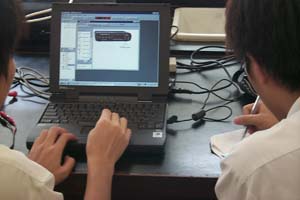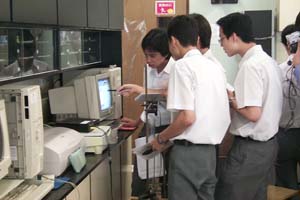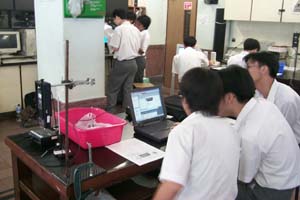
Pun-hon NG and Yau-yuen YEUNG
Implications of Data-logging on A.L. Physics Experiments: A Preliminary Study
| Previous Contents Next |
|
|
 |
Asia-Pacific
Forum on Science Learning and Teaching, Volume 1, Issue 2, Article 5 (Dec., 2000)
Pun-hon NG and Yau-yuen YEUNG Implications of Data-logging on A.L. Physics Experiments: A Preliminary Study
|
Responses and DiscussionsIn the first practical session, the teacher (Figure 1) gave a one-hour introduction on the hardware and the software, and demonstrated the important functions of the software with the bouncing ball experiment.
Figure 1: Teacher introducing the usage of the hardware and software for the data-logging systemThis practice is quite common when something new is introduced to students. Then the students did their first experiment (Figures 2, 3 and 4). After completing all the three experiments, students needed to fill in a questionnaire.

Figure 2: Students using the computer software to manipulate the data-logging system
Figure 3: Students doing the bouncing ball experiment
(video clip: experiment.mov; 9.52MB)
Figure 4: Students working on another data-logger experimentForty-one students filled the questionnaire. Only one student did not have a personal computer at home but he rated his computer competency to be basic (i.e. knowing Windows and word-processing operation). Hence all students acquired those basic computer operation skills such as mouse operation in the Window environment. Their grades in Physics in public examination ranges from A (excellent) to E (marginally pass), reflecting a diverse background of physics standard. In the questionnaire, the students were asked to evaluate the learning effectiveness and attitudes of data-logging. Most of them (~80 %) agreed or strongly agreed that data-logging could enhance data measurement, data recording and the presentation of results during the experiment as well as could develop their skills in these aspects. They also strongly agreed that data-logging could assist data analysis during the experiment but only 50 % agreed that their corresponding skill could be improved through such process. They also slightly agreed that data-logging could assist the manipulation of apparatus and the observation of phenomena. They were almost neutral in considering whether data-logging had positive impact on making scientific inferences, inducing curiosity, enhancing collaborative learning and developing a sense of achievement. The reason may be owing to the fact that 80 % of them found the software difficult to use. Actually the authors and two officers from the Curriculum Development Institute observed that session and all agreed that the introduction of the software by the teacher was lively, detailed and comprehensive. The teacher had covered all the important and necessary aspects about the software. The approach on how to guide the students to become familiar with the software needs further investigation.
Another two weeks later, a short interview was conducted separately with different groups of students. They were generally positive about data-logging but some made very perceptive criticisms. They appreciated the powerful features of the hardware and the accuracy, the recording speed and the presentation of the data. Comments included:
The sampling of data is very fast and we can have time to repeat the experiment if the data is not satisfactory.
The sensors are very sensitive and they can measure something we can't measure before.
The plotting of graph manually is really tedious. I like the graphical function of the software and the graph is indeed very smooth.
The data is very accurate and I like the software can present several sets of data on the same graph.
There was a common feeling amongst the students that the experiments were quite different from those they were used to. They were also not used to the investigative approach. Critical comments included:
It is boring. There is little thing we need to do as the computer does most of the job.
I still prefer the conventional way of doing experiment. For instance, I like to adjust the voltage gain of a CRO by myself to measure an electrical signal, rather than the data-logging software automatically selecting the gain. Moreover, the A.L. examination requires us to know those skills such as adjusting the voltage gain of a CRO.
Data-logging is helpful in obtaining and presenting the data but do little in developing my experimental technique.
It is always those IT competent classmates to dominate the experiment. There is little chance to work collaboratively.
The authors have also discussed with the teacher about his views on the applications of data-logging in physics teaching. Generally he had quite positive comments on data-logging. As he had rich experience in designing student activities, he had little problem in operating the data-logger. He raised two worries about the actual implementation of data-logging activities in laboratory:
It is quite difficult to find enough computers for student activities. Discipline is another problem as the students may be distracted to play with other software in the computer.
It is easy to use another stopwatch if it goes wrong in a conventional experiment. However there is little a teacher can do if something goes wrong in a data-logging experiment. He predicted that this would hinder those teachers with low IT competency from experimenting with data-loggers.
Copyright (C) 2000 HKIEd APFSLT. Volume 1, Issue 2, Article 5 (Dec., 2000)